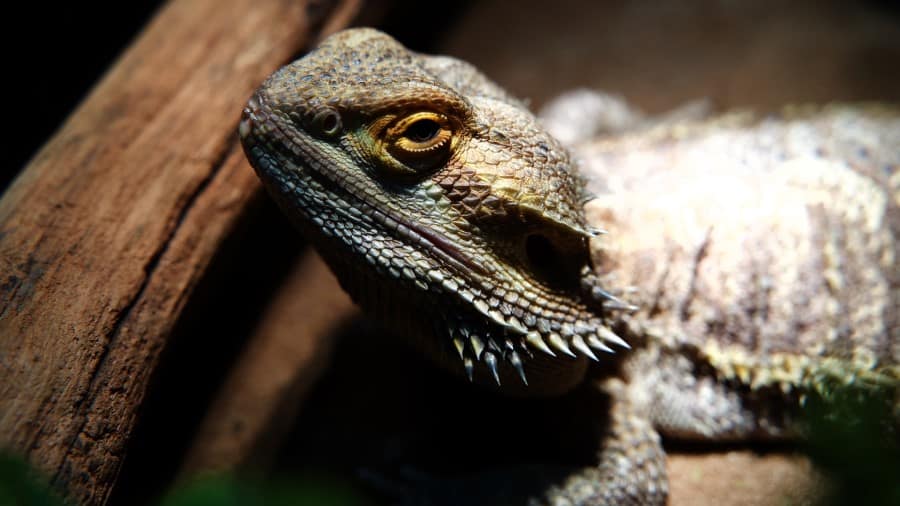
Different animals have different sleeping habits and their favorite sleeping spot according to their habitat environment. These sleeping spots are usually covered and hidden. Since bearded dragons live in dry woodland, you might wonder where they sleep?
Bearded dragons prefer to sleep somewhere hidden and away from their predator. In the wild, they shelter themselves either on top or on the side of tree branches. They also tend to sleep under the fallen tree, hollow logs, or rocks.
However, in an open area with no shades to be found in the surrounding, bearded dragons will dig down the sand and sleep in the burrows. It is the same in captivity, bearded dragons also prefer the same hides that give them the feeling of enclosure.
In general, regarding sleeping places, the main concern of bearded dragons is safety. They prefer a place where they will not get preyed on by their predators.
Other than safety, bearded dragons also need to have a lower temperature to get into a deep sleep. In this article, you will find out the sleeping habits of bearded dragons.
Where Do Bearded Dragons Sleep In The Wild?
There are mainly three types of terrains that can be found in the habitat of bearded dragons which are scrubs and low trees area, rocky areas, and the open desert. Bearded dragons have different sleeping places according to the terrains.
Bearded Dragons’ Sleeping Places In Scrub And Low Trees Area
When bearded dragons are in this kind of area, they will hide on branches and under leaves. This makes sense as bearded dragons are semi-arboreal.
Sometimes, you may find they even sleep vertically against the tree. The reason why bearded dragons stay at higher places is to avoid their predators.
Also, bearded dragons can easily camouflage into the surrounding. This makes them feel safer and less stressed. If there are no trees nearby and only fallen trees or hollow logs can be found, bearded dragons will make use of it by hiding underneath it.
In bearded dragons thought, underneath hollow logs can at least protect them from the attacks coming from above.
Bearded Dragons’ Sleeping Places In the Desert Area
In a desert area with a wide-open space, bearded dragons will dig a burrow and sleep in it. This burrow is usually deep enough for bearded dragons to partially or completely hide under the substrate.
Not only does this sleeping place hides bearded dragons from their predators, but it also regulates their body temperature. Bearded dragons need a surrounding temperature of 20°C to fall into a deep sleep.
This is difficult to achieve if bearded dragons just sleep in the middle of the desert without shelter. A burrow will help to lower down the temperature and maintain it.
Bearded Dragons’ Sleeping Places In Rocky Area
In a rocky area, bearded dragons will either hide underneath a rock or inside a cave. They will also make a burrow if the substrate allows them to do so.
Where Do Bearded Dragons Sleep In The Captivity
The sleeping habits of bearded dragons stay the same no matter if they are in the wild or in captivity. Although there is no real danger in their terrarium, bearded dragons might still get scared by whatever they can see outside the tank.
Hence, they still prefer a hidden place that provides the right temperature and also makes them feel safe. Examples of these hidden places are tree branches, rocks, and hollow logs.
If the substrate inside the tank allows the bearded dragon to dig a hole, you may see them sleep underground as well.
How to Make Sure Bearded Dragons Sleep Well In The Captivity?
As we have learned that even in a terrarium, bearded dragons can only fall asleep when they feel safe and relax. Hence, here are three aspects you need to consider to make sure bearded dragons sleep well. The things to put inside the tank, the size of the tank, the temperature, and humidity inside the tank.
Things to Put Inside The Tank
Set up the tank with stuff that provides darkness and height. For example rocks, tree branches, and hollow logs. These can be natural or man-made.
A substrate that allows bearded dragons to make burrows could also be a good choice. However, be careful when choosing substrate as some bearded dragons tend to eat sand and it isn’t good for their health.
Size of the Tank
Make sure the tank has sufficient space for bearded dragons. They need a spacious living environment to feel relaxed. A small tank also couldn’t provide a high sleeping place for the bearded dragons. Adult bearded dragons need a tank of 55 gallons, at minimum.
Temperature and Lighting
Bearded dragons sleep well at a temperature of around 20°C in combination with a dark environment to fall asleep. Hence, the light should be off at night to provide darkness and a lower temperature to help bearded dragons sleep the best.
When Do Bearded Dragons Sleep?
Some people might think that bearded dragons might be nocturnal but they are actually diurnal. Their circadian rhythms are just like us humans, staying awake during the day and sleep when the sun goes down. In that sense, you and your bearded dragons should go to bed at the same time, given that you don’t sleep too late.
How Long Do Bearded Dragons Sleep?
As mentioned earlier, bearded dragons share the same circadian rhythms as us humans. However, bearded dragons usually sleep for 8 to 12 hours. This is 4 hours more than what a normal adult usually acquired.
Throughout these 8 to 12 hours, there are two sleep cycles. Coincidently, these two same cycles of bearded dragons can be found in the birds and mammals as well.
These short sleep cycles consist of Rapid Eye Movement (REM) sleep and short wave sleep. Unlike humans, bearded dragons have a much more regular and shorter sleep cycle. Their sleep cycle only lasts 80 seconds and is split equally between REM sleep and short wave sleep.
Conclusion
In conclusion, where bearded dragons sleep varies according to their surroundings. Doesn’t matter if they are in the wild or in captivity, they like to sleep on branches with heights, underneath a rock, and inside burrows.
The reason why is because they want to feel safe from their predators. Moreover, bearded dragons choose these sleeping spots because they provide a dark and chilly place to sleep in.
Hence, in captivity, a tank with the proper environment set up is very important for your bearded dragon to sleep well. They need to sleep at least 8 to 12 hours to be properly rested.


